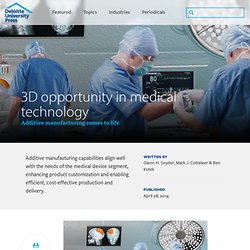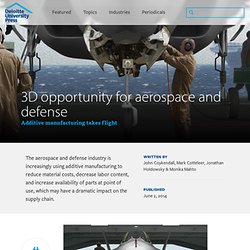

Will 3-D Printers Change the World? - Room for Debate. Are we expecting too much from these 3-D printers?

Christopher Gregory for The New York Times For the last half-decade, three-dimensional printing has been billed as the next revolution in manufacturing. The Economist and Wired have declared it world-changing technology. Last year, retailers including Staples and Amazon began to sell their own 3-D printers, and this year, Amazon has introduced a marketplace for 3-D printed objects.
But for all the hype, it’s still unclear exactly how and when 3-D printing will have an impact on our daily lives. Additive manufacturing: 3D opportunity for future medical technology. AM and medical devices: A natural fit The medical technology (medtech) industry has been a leader in the use of additive manufacturing (AM), also known as “3D printing.”

In 2012, medical applications accounted for 16.4 percent of the total system-related revenue for the AM market.1 A key reason for this is that AM capabilities align well with the needs of medtech’s medical device segment. AM capabilities align well with the needs of medtech’s medical device segment. The medtech industry is also relatively well funded, which gives it the resources to invest in new technologies.
The industry’s 2012 revenue was estimated at $121.6 billion, with an annual expected growth rate of 5.4 percent.4 The 15-year total shareholder return (1998–2012) for medtech companies was 7.8 percent, compared with the Standard & Poor’s 500 average of 5.2 percent.5 But to sustain this performance, the industry needs to continue to deliver innovative solutions to address patient needs.6 Four tactical paths. Additive manufacturing: 3D opportunity for the automotive industry. Introduction Significant advances in additive manufacturing (AM) technologies, commonly known as 3D printing, over the past decade have transformed the potential ways in which products are designed, developed, manufactured, and distributed.1 For the automotive industry, these advances have opened doors for newer designs; cleaner, lighter, and safer products; shorter lead times; and lower costs.

While automotive original equipment manufacturers (OEMs) and suppliers primarily use AM for rapid prototyping, the technical trajectory of AM makes a strong case for its use in product innovation and high-volume direct manufacturing in the future. New developments in AM processes, along with related innovations in fields such as advanced materials, will benefit production within the automotive industry as well as alter traditional manufacturing and supply chain pathways. 3D opportunity in aerospace and defense: Additive manufacturing takes flight. Additive manufacturing (AM), popularly known as 3D printing, is a manufacturing technique that builds objects layer by layer using materials such as polymers, metals, and composites.

Figure 1 depicts the overall AM process.1 In the early stages of the 30 years of AM’s deployment, the technology was largely geared toward prototyping and tooling applications; however, in recent years, AM has found success in end-part production, driven by improved manufacturability and reduced lead time compared to traditional manufacturing methods. The aerospace and defense (A&D) industry was an early adopter of AM technology. The history of AM traces back to 1983 with some A&D companies beginning experimentation with the technology as early as 1988.2 Over the years, AM’s adoption has increased across industries, with the A&D industry contributing about 10.2 percent of AM’s $2.2 billion global revenues in 2012.3 Several reasons underlie AM’s relatively widespread adoption in A&D. See endnote 6. Shapeways - Design, buy, and sell products with 3D Printing.
Cubify - Express Yourself in 3D. Thingiverse - Digital Designs for Physical Objects. M.Lab 21: Bringing the 21st Century to the Classroom. By Leanne Gluck, Director of Social Impact For as long as I have been in the manufacturing industry, we have been talking about the need for three things: to make manufacturing “cool again,” to bridge the Skills Gap, and to strengthen the conversation between industry and education.

We talk theoretically about our opportunities to support the next generation and innovation in the US, but the question on my mind has always been the concrete “How?” Yesterday, 3D Systems and the SME Education Foundation created one answer to that question, announcing a collaborative initiative to enhance high school industrial arts and vocational education classes called M.Lab21. M.Lab 21 is part maker/part manufacturing, and will provide students with starter kits outfitted with the latest 3D design and printing technology, including the Touch haptic device, the Sense 3D scanner, advanced prosumer desktop printers like the CubePro, and a suite of Cubify design software.